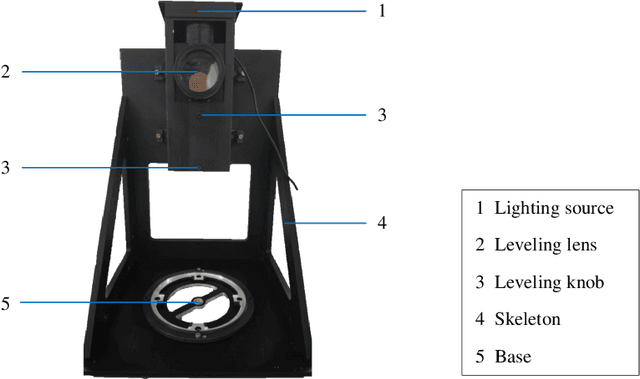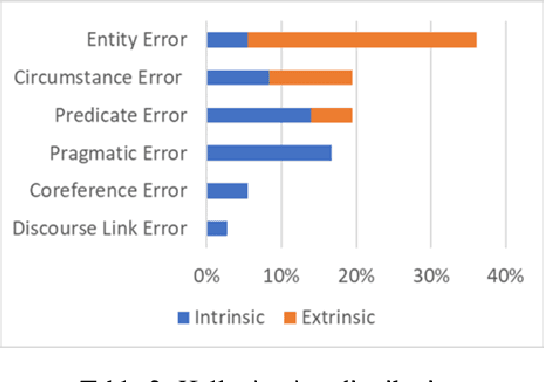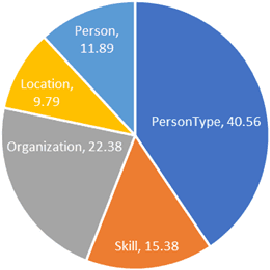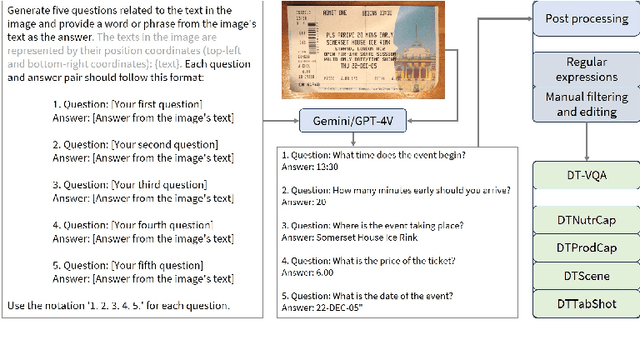Zhang Li
MSTAR: Box-free Multi-query Scene Text Retrieval with Attention Recycling
Jun 12, 2025Abstract:Scene text retrieval has made significant progress with the assistance of accurate text localization. However, existing approaches typically require costly bounding box annotations for training. Besides, they mostly adopt a customized retrieval strategy but struggle to unify various types of queries to meet diverse retrieval needs. To address these issues, we introduce Muti-query Scene Text retrieval with Attention Recycling (MSTAR), a box-free approach for scene text retrieval. It incorporates progressive vision embedding to dynamically capture the multi-grained representation of texts and harmonizes free-style text queries with style-aware instructions. Additionally, a multi-instance matching module is integrated to enhance vision-language alignment. Furthermore, we build the Multi-Query Text Retrieval (MQTR) dataset, the first benchmark designed to evaluate the multi-query scene text retrieval capability of models, comprising four query types and 16k images. Extensive experiments demonstrate the superiority of our method across seven public datasets and the MQTR dataset. Notably, MSTAR marginally surpasses the previous state-of-the-art model by 6.4% in MAP on Total-Text while eliminating box annotation costs. Moreover, on the MQTR benchmark, MSTAR significantly outperforms the previous models by an average of 8.5%. The code and datasets are available at https://github.com/yingift/MSTAR.
MonkeyOCR: Document Parsing with a Structure-Recognition-Relation Triplet Paradigm
Jun 05, 2025Abstract:We introduce MonkeyOCR, a vision-language model for document parsing that advances the state of the art by leveraging a Structure-Recognition-Relation (SRR) triplet paradigm. This design simplifies what would otherwise be a complex multi-tool pipeline (as in MinerU's modular approach) and avoids the inefficiencies of processing full pages with giant end-to-end models (e.g., large multimodal LLMs like Qwen-VL). In SRR, document parsing is abstracted into three fundamental questions - "Where is it?" (structure), "What is it?" (recognition), and "How is it organized?" (relation) - corresponding to layout analysis, content identification, and logical ordering. This focused decomposition balances accuracy and speed: it enables efficient, scalable processing without sacrificing precision. To train and evaluate this approach, we introduce the MonkeyDoc (the most comprehensive document parsing dataset to date), with 3.9 million instances spanning over ten document types in both Chinese and English. Experiments show that MonkeyOCR outperforms MinerU by an average of 5.1%, with particularly notable improvements on challenging content such as formulas (+15.0%) and tables (+8.6%). Remarkably, our 3B-parameter model surpasses much larger and top-performing models, including Qwen2.5-VL (72B) and Gemini 2.5 Pro, achieving state-of-the-art average performance on English document parsing tasks. In addition, MonkeyOCR processes multi-page documents significantly faster (0.84 pages per second compared to 0.65 for MinerU and 0.12 for Qwen2.5-VL-7B). The 3B model can be efficiently deployed for inference on a single NVIDIA 3090 GPU. Code and models will be released at https://github.com/Yuliang-Liu/MonkeyOCR.
High-precision visual navigation device calibration method based on collimator
Feb 25, 2025



Abstract:Visual navigation devices require precise calibration to achieve high-precision localization and navigation, which includes camera and attitude calibration. To address the limitations of time-consuming camera calibration and complex attitude adjustment processes, this study presents a collimator-based calibration method and system. Based on the optical characteristics of the collimator, a single-image camera calibration algorithm is introduced. In addition, integrated with the precision adjustment mechanism of the calibration frame, a rotation transfer model between coordinate systems enables efficient attitude calibration. Experimental results demonstrate that the proposed method achieves accuracy and stability comparable to traditional multi-image calibration techniques. Specifically, the re-projection errors are less than 0.1463 pixels, and average attitude angle errors are less than 0.0586 degrees with a standard deviation less than 0.0257 degrees, demonstrating high precision and robustness.
OCRBench v2: An Improved Benchmark for Evaluating Large Multimodal Models on Visual Text Localization and Reasoning
Dec 31, 2024



Abstract:Scoring the Optical Character Recognition (OCR) capabilities of Large Multimodal Models (LMMs) has witnessed growing interest recently. Existing benchmarks have highlighted the impressive performance of LMMs in text recognition; however, their abilities on certain challenging tasks, such as text localization, handwritten content extraction, and logical reasoning, remain underexplored. To bridge this gap, we introduce OCRBench v2, a large-scale bilingual text-centric benchmark with currently the most comprehensive set of tasks (4x more tasks than the previous multi-scene benchmark OCRBench), the widest coverage of scenarios (31 diverse scenarios including street scene, receipt, formula, diagram, and so on), and thorough evaluation metrics, with a total of 10,000 human-verified question-answering pairs and a high proportion of difficult samples. After carefully benchmarking state-of-the-art LMMs on OCRBench v2, we find that 20 out of 22 LMMs score below 50 (100 in total) and suffer from five-type limitations, including less frequently encountered text recognition, fine-grained perception, layout perception, complex element parsing, and logical reasoning. The benchmark and evaluation scripts are available at https://github.com/Yuliang-liu/MultimodalOCR.
Developing a Reliable, General-Purpose Hallucination Detection and Mitigation Service: Insights and Lessons Learned
Jul 22, 2024



Abstract:Hallucination, a phenomenon where large language models (LLMs) produce output that is factually incorrect or unrelated to the input, is a major challenge for LLM applications that require accuracy and dependability. In this paper, we introduce a reliable and high-speed production system aimed at detecting and rectifying the hallucination issue within LLMs. Our system encompasses named entity recognition (NER), natural language inference (NLI), span-based detection (SBD), and an intricate decision tree-based process to reliably detect a wide range of hallucinations in LLM responses. Furthermore, our team has crafted a rewriting mechanism that maintains an optimal mix of precision, response time, and cost-effectiveness. We detail the core elements of our framework and underscore the paramount challenges tied to response time, availability, and performance metrics, which are crucial for real-world deployment of these technologies. Our extensive evaluation, utilizing offline data and live production traffic, confirms the efficacy of our proposed framework and service.
Exploring the Capabilities of Large Multimodal Models on Dense Text
May 09, 2024



Abstract:While large multi-modal models (LMM) have shown notable progress in multi-modal tasks, their capabilities in tasks involving dense textual content remains to be fully explored. Dense text, which carries important information, is often found in documents, tables, and product descriptions. Understanding dense text enables us to obtain more accurate information, assisting in making better decisions. To further explore the capabilities of LMM in complex text tasks, we propose the DT-VQA dataset, with 170k question-answer pairs. In this paper, we conduct a comprehensive evaluation of GPT4V, Gemini, and various open-source LMMs on our dataset, revealing their strengths and weaknesses. Furthermore, we evaluate the effectiveness of two strategies for LMM: prompt engineering and downstream fine-tuning. We find that even with automatically labeled training datasets, significant improvements in model performance can be achieved. We hope that this research will promote the study of LMM in dense text tasks. Code will be released at https://github.com/Yuliang-Liu/MultimodalOCR.
3MOS: Multi-sources, Multi-resolutions, and Multi-scenes dataset for Optical-SAR image matching
Apr 01, 2024



Abstract:Optical-SAR image matching is a fundamental task for image fusion and visual navigation. However, all large-scale open SAR dataset for methods development are collected from single platform, resulting in limited satellite types and spatial resolutions. Since images captured by different sensors vary significantly in both geometric and radiometric appearance, existing methods may fail to match corresponding regions containing the same content. Besides, most of existing datasets have not been categorized based on the characteristics of different scenes. To encourage the design of more general multi-modal image matching methods, we introduce a large-scale Multi-sources,Multi-resolutions, and Multi-scenes dataset for Optical-SAR image matching(3MOS). It consists of 155K optical-SAR image pairs, including SAR data from six commercial satellites, with resolutions ranging from 1.25m to 12.5m. The data has been classified into eight scenes including urban, rural, plains, hills, mountains, water, desert, and frozen earth. Extensively experiments show that none of state-of-the-art methods achieve consistently superior performance across different sources, resolutions and scenes. In addition, the distribution of data has a substantial impact on the matching capability of deep learning models, this proposes the domain adaptation challenge in optical-SAR image matching. Our data and code will be available at:https://github.com/3M-OS/3MOS.
TextMonkey: An OCR-Free Large Multimodal Model for Understanding Document
Mar 15, 2024Abstract:We present TextMonkey, a large multimodal model (LMM) tailored for text-centric tasks. Our approach introduces enhancement across several dimensions: By adopting Shifted Window Attention with zero-initialization, we achieve cross-window connectivity at higher input resolutions and stabilize early training; We hypothesize that images may contain redundant tokens, and by using similarity to filter out significant tokens, we can not only streamline the token length but also enhance the model's performance. Moreover, by expanding our model's capabilities to encompass text spotting and grounding, and incorporating positional information into responses, we enhance interpretability. It also learns to perform screenshot tasks through finetuning. Evaluation on 12 benchmarks shows notable improvements: 5.2% in Scene Text-Centric tasks (including STVQA, TextVQA, and OCRVQA), 6.9% in Document-Oriented tasks (such as DocVQA, InfoVQA, ChartVQA, DeepForm, Kleister Charity, and WikiTableQuestions), and 2.8% in Key Information Extraction tasks (comprising FUNSD, SROIE, and POIE). It outperforms in scene text spotting with a 10.9\% increase and sets a new standard on OCRBench, a comprehensive benchmark consisting of 29 OCR-related assessments, with a score of 561, surpassing previous open-sourced large multimodal models for document understanding. Code will be released at https://github.com/Yuliang-Liu/Monkey.
Monkey: Image Resolution and Text Label Are Important Things for Large Multi-modal Models
Nov 24, 2023



Abstract:Large Multimodal Models (LMMs) have shown promise in vision-language tasks but struggle with high-resolution input and detailed scene understanding. Addressing these challenges, we introduce Monkey to enhance LMM capabilities. Firstly, Monkey processes input images by dividing them into uniform patches, each matching the size (e.g., 448x448) used in the original training of the well-trained vision encoder. Equipped with individual adapter for each patch, Monkey can handle higher resolutions up to 1344x896 pixels, enabling the detailed capture of complex visual information. Secondly, it employs a multi-level description generation method, enriching the context for scene-object associations. This two-part strategy ensures more effective learning from generated data: the higher resolution allows for a more detailed capture of visuals, which in turn enhances the effectiveness of comprehensive descriptions. Extensive ablative results validate the effectiveness of our designs. Additionally, experiments on 18 datasets further demonstrate that Monkey surpasses existing LMMs in many tasks like Image Captioning and various Visual Question Answering formats. Specially, in qualitative tests focused on dense text question answering, Monkey has exhibited encouraging results compared with GPT4V. Code is available at https://github.com/Yuliang-Liu/Monkey.
On the Hidden Mystery of OCR in Large Multimodal Models
May 13, 2023Abstract:Large models have recently played a dominant role in natural language processing and multimodal vision-language learning. It remains less explored about their efficacy in text-related visual tasks. We conducted a comprehensive study of existing publicly available multimodal models, evaluating their performance in text recognition, text-based visual question answering, and key information extraction. Our findings reveal strengths and weaknesses in these models, which primarily rely on semantic understanding for word recognition and exhibit inferior perception of individual character shapes. They also display indifference towards text length and have limited capabilities in detecting fine-grained features in images. Consequently, these results demonstrate that even the current most powerful large multimodal models cannot match domain-specific methods in traditional text tasks and face greater challenges in more complex tasks. Most importantly, the baseline results showcased in this study could provide a foundational framework for the conception and assessment of innovative strategies targeted at enhancing zero-shot multimodal techniques. Evaluation pipeline will be available at https://github.com/Yuliang-Liu/MultimodalOCR.
 Add to Chrome
Add to Chrome Add to Firefox
Add to Firefox Add to Edge
Add to Edge